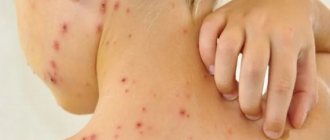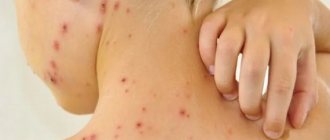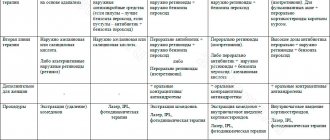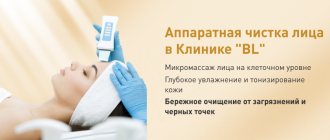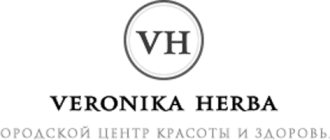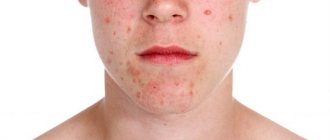- Acne treatment
- Treatment of demodicosis
- Rosacea Treatment
Acne treatment is a set of cosmetic and therapeutic procedures aimed not only at treating problem areas of the skin with pronounced manifestations of the inflammatory process, but also at improving the health of the body as a whole.
Acne is a fairly common chronic skin disease, which in most cases occurs as a result of the proliferation of provoking bacteria, excess sebum production, and an increase in the amount of keratin in the cells of the hair follicles. Most often, signs of the disease appear on the face, chest and back, that is, in areas of the skin with a large number of sebaceous glands.
Conglobate acne97
Bluish-red inflammatory nodes with a diameter of 1-2 cm lie deep in the dermis and subcutaneous fat. At first their consistency is dense, later it softens, holes appear from which pus comes out.
Conglobate acne can merge into infiltrates, forming hypertrophied nodes. Once the rash resolves, scarring is likely to remain. Sometimes large, deeply located acne elements heal with the formation of hemorrhagic crusts.
This severe form of acne is characterized by the appearance of:
- polyporous open comedones;
- granulomatous inflammatory elements;
- nodes;
- cyst;
- abscesses.
After the inflammatory elements resolve, scars remain.
Types of acne treatment
The choice of acne treatment method depends on the stage of development of the disease. All types of acne described above belong to three stages of disease development. The first stage is mild, characterized by the presence of comedones and up to 10 papulopustules. The middle stage is characterized by the presence of more than 10 papulopustules and up to 5 nodules (acne formed by the fusion of several pimples). At the most severe stage of the disease, conglobate acne forms on the skin.
The following acne treatment methods are available:
- drug treatment - based on erythromycin and tetracycline drugs, as well as retinoids for topical use, antifungal drugs and regenerating stimulants, such as acnecutane, roaccutane and so on;
- injection treatment - subcutaneous injection into the affected area of active substances that contribute to the destruction of acne elements; This group of methods includes biorevitalization, mesotherapy, plasma lifting;
- laser treatment - a method of treating affected areas of the skin with laser flashes that specifically target acne lesions;
- hardware treatment - mechanical cleaning, chemical peelings, phototherapy, and so on;
- Combination treatment is the most effective and frequently practiced type of therapy, which is a complex of previously described treatment methods.
As a rule, for mild cases of the disease, external therapy is sufficient. When treating acne of moderate and severe severity, systemic treatment is added to external therapy, medications and deep laser/hardware procedures are prescribed. However, any treatment method has limitations and contraindications.
Inverse acne 97
Hidradenitis suppurativa is a chronic, scar-prone suppurative disease of the apocrine glands. Pathology mainly develops in the anogenital, axillary zones, and on the mammary glands. The formation of the disease sometimes occurs against the background of existing acne.
The causes of hidradenitis suppurativa can be hereditary, and a connection with hormonal disorders has also been found. The clinical picture of inverse acne can be represented by pustules and papules, but it is still dominated by inflammatory nodes and sinus tracts, from which pus is released, which has an unpleasant odor.
Inverse acne can stop spontaneously or progress over several years. Due to the severity of the disease and the causes of its occurrence, patients often have to contact not only a dermatologist and cosmetologist, but also a gynecologist and a plastic surgeon.
Types of acne
- 1. Successful acne treatment
- 2. Acne in teenagers
- 3. Acne in adults
- 4. Treatment of acne
- 5. Post-acne: treatment of spots and scars
- 6. Types of acne
- 7. Causes of acne
- 8. Hardware techniques in the treatment of acne
- 9. Retinoids, retinoid treatment
- 10. Acne and homeopathy
- 11. PDT HELEO4 for acne
To prescribe the right treatment for acne, the doctor examines the patient’s skin and determines the type of acne. It depends on this what medications will be prescribed for acne and acne, what cosmetic procedures for facial skin will be appropriate, what additional studies of the skin or body need to be carried out.
Acne can be considered for various reasons:
Types of acne by age
There are teenage acne and adult acne (late). Juvenile acne on the face is localized mainly on the forehead, in the temporal areas, acne in adults is more often in the lower part of the face.
Types of acne by location
Pimples appear on the face, temples, cheeks, back, chest, forehead, chin, nose. Sometimes the localization of skin rashes can indicate to the doctor the connection between a skin disease and a problem inside the body, for example, in the gastrointestinal tract, or reveal a hidden process in the endocrine system, in the nasopharynx, etc. But to make a diagnosis only by the location of the acne, of course , it is forbidden. This is the basis for a more targeted examination.
Types of acne according to clinical picture: non-inflammatory acne, inflammatory acne
Non-inflammatory acne, or blackheads, are comedones, i.e. accumulations of sebum and keratin in the hair follicle. They can be open or closed. Comedones on the face appear in the form of a cluster of black dots, less often - in the form of white tubercles.
Open comedones are formed when sebum clogs the mouth of the hair follicle and a non-inflamed dark element, the so-called blackhead, forms. The mouth of the hair follicle in such a comedon is open.
Closed comedones appear when the follicle is filled with sebum, but its mouth is closed and there is no exit of the contents. Patients characterize it as a whitehead (subcutaneous pimples).
Inflammatory acne is formed when microbes in the comedone are activated. Visible inflammation appears on the skin, many patients refer to it as acne vulgaris. In this case, severe forms of acne may develop. Pimples are bright red in color, painful, and can be large, deep, and resemble a boil. If left untreated, deep elements leave behind a scar.
A separate type is rosacea (rosacea). They are characterized by persistent redness with a pronounced vascular pattern (especially in the cheek area). Against the background of redness, papules (small juicy nodules), sometimes “knots,” develop.
Types of acne by severity
Stage 1 is the mildest form of acne. A small number of pimples, often without inflammatory processes. When a pimple disappears, scars and cicatrices do not remain.
Grade 2 – moderate manifestation of acne. Quite profuse rashes with pustules, blackheads and other variations.
Stage 3 – severe form of acne. Pimples on the body and face are large, often deep, and present in large numbers. Constant inflammation and suppuration. Post-acne manifestations are noticeable: red spots and scars.
Stage 4 is the most severe form of acne. A very large number of acne of different types, shades and sizes, the formation of nodules and cysts. Sometimes there is complete damage to any part of the body (face, back, chest). Large scars remain.
If you care about the health and beauty of your skin, we recommend promptly contacting a dermatologist for any severity of acne. Experienced doctors at the Danae Clinic are not afraid of even the most complex and advanced cases and will definitely help you cope with the problem.
To get a consultation
Rash that is associated with epidermal growth factor receptor inhibitor
There are chemotherapy drugs, the use of which can cause the formation of a follicular rash. EGFR inhibitors include:
- gefitinib;
- cetuximab;
- erlotinib;
- trastuzimab.
Patients who respond to treatment are given EGFR inhibitors indefinitely, which slow tumor growth. But they have a side effect - the formation of a perifollicular papulopustular rash on the face and upper torso. Rashes appear in 86% of patients.
Fighting rashes
There are many treatment options for skin conditions. The main drugs that help get rid of not only rashes, but also their causes include products containing tetracycline or retinol. They are able to eliminate bacteria that cause inflammation on the skin.
These products also include creams containing salicylic acid, which helps eliminate inflammation and normalize the functioning of the sebaceous glands.
- atrophic gastritis treatment
- Men's signets: old new trend
- 3 types of medical gloves and why you should buy them in the MEDSTOR online store
To relieve irritation and redness on the skin, dermatologists recommend creams based on sage, eucalyptus and calendula.
Pimples on the forehead. Before and after
This path to clear skin turned out to be short-lived, but it was not without losses. And we lost kilograms of dairy products along the way. It was difficult in places, sometimes you ask for milk in your coffee, sometimes the omelette winks
Of course, we selected therapeutic care and a regimen of external medications. As you can see from the feedback, it turned out that clear skin is worth these efforts, which ultimately become the norm and do not cause problems.
When the skin has cleared, there is no need to relax with either care or nutrition. The tendency to rashes will be with you all your life and your skin will find a reason to remind you of it, believe me.
Yes, it is possible to gradually return products after some time, just in a smaller volume and not all of them. This is discussed with your doctor.
Cosmetologist's work:
- Clean forehead
- Skin without rashes
- Selected care
- External preparations
- Got rid of dairy products
- Will remain prone to rashes
Acne treatment
There is no single treatment regimen, so it is best to consult a dermatologist-cosmetologist. After the examination and if necessary, the doctor:
- Prescribe tests that can help determine the cause of acne.
- Prescribe a course of external treatment and, if necessary, depending on the severity of acne, systemic medications taken orally.
- Develop a program for cleansing, toning and moisturizing the skin. She will select cosmetics for daily care, recommend decorative cosmetics, foundations, and sunscreens.
- Prescribe cosmetic procedures that will relieve inflammation and help cope with the consequences of acne.
- It will help you develop an individual diet aimed at cleansing and healing the entire body, and therefore the skin.
Post-acne on the face, vascular network. Before and after
Most often, working on skin quality is not a very quick process. The advantage is that we can enhance active procedures with home care, gradually add those procedures that are needed, and increase the impact. In this case, we met once every 2 weeks for the first 3 months, and then once a month. And gradually we came to this result.
It’s hard not to notice it from the photo, but in fact, the patient was very surprised to see the “before” photo, because she saw the improvements gradually and also got used to them. We relieved inflammation, removed post-acne spots, evened out the complexion (working with the vascular network). Yes, not quickly, there is a 1.5-2 year difference between the photos, it could have been faster if desired. As a result, we got a huge difference, the patient is happy and most importantly, she now knows what results thoughtful facial skin care gives.
Traditional methods
The most popular means are:
- Brewer's yeast. To improve metabolic processes in cells.
- Tea tree oil. To combat inflamed skin areas.
- Clay. Clay masks have long been in the arsenal of many girls due to their properties of cleansing and nourishing the skin, as well as to prevent the appearance of rashes and inflammations
Table of contents
- Etiology and pathogenesis
- Clinical manifestations
- Principles of treatment
Acne (pimples, acne vulgaris, acne, comedones, acne vulgaris) is a chronic inflammatory skin disease that manifests itself as open or closed comedones and inflammatory lesions (papules, pustules, nodules).
In our company you can purchase the following equipment for acne treatment:
- M22 (Lumenis)
- Thermage (Solta Medical)
Today, acne, without exaggeration, can be called the most common skin disease among young people - according to statistics, up to 95% of boys and up to 83% of girls suffer from it. Approximately 60% of them have a mild form with a small number of rashes (so-called physiological acne). If acne occurs in adolescence, in 64% of adults, acne persists at the age of 20–30 years, in 43% at 30–40 years, in 15% at 40–50 years (more often in women).
Pimples on the cheeks. Before and after
Solving your acne problem is often only half the battle.
This beauty fell into my hands after almost all the rashes had passed. There were small scars left, lucky that they were quite flat (level with the skin, the relief was practically unchanged) and already quite annoying stagnant spots. The request was to work specifically with skin tone, i.e. with bluish spots.
The result in the photo is not just one procedure; it seems to me that the difference between the photos is about a year. But the visits were not frequent, mostly once every 4 weeks. Some procedures were traumatic, others not so much.
The effect increased gradually, but my patient began to notice improvements almost immediately. I remember how they laughed, her mother did not believe that this was the work of a cosmetologist
“It can’t be, most likely you’ve started eating normally,” my mother said. But actually, this is even a compliment; modern methods can do a lot, despite the fact that they believe in diet more))
The spots are gone, the scars partially remain, but they are small and almost invisible. The skin tone is much more even, which is what we wanted. And most importantly, happy eyes
Cosmetologist's work:
- Permanent procedures
- Once every 4 weeks
- Increasing effect
- Even skin tone
Causes of rashes
Many representatives of the fair sex love to take photographs. However, it is unlikely that anyone would want to take such photos with rashes on different parts of the body, especially the face. Of course, you can resort to the help of cosmetics, but you need to remember that sometimes it can only aggravate the situation.
So, among the main factors that provoke the occurrence of rashes are:
Menstruation. A considerable number of girls and women experience rashes during or before their periods.
Stop taking hormonal medications. If a woman is taking birth control pills, stopping the pill increases the risk of acne. Such drugs contain androgen, which can give you a whole bunch of different rashes.
Metabolic disorder. Improper nutrition disrupts metabolic processes in the body, and can also lead to the appearance of pimples and even acne.
Stress. As they say, all diseases come from nerves. Any significant stress, whether spontaneous or constant, can lead to the formation of a rash on the neck, face or back. A stressful state entails hormonal imbalance, which ultimately leads to rashes of various types.
Cosmetics. Some cosmetics contain comedogenic substances. It is not recommended to use such representatives daily, otherwise you risk getting clogged pores, which naturally leads to breakouts.
Purity. Yes, it sounds strange, but it is cleanliness, or rather excessive cleanliness, that can cause formations on the face. With frequent use of alcohol-containing lotions, the skin loses its natural protective barrier. If you add creams or oil-based micellar waters to these products, then clogging of pores will not take long to occur.
Professional acne and chloracne
Another type of acne is professional acne. The pathology occurs due to prolonged contact with certain industrial chemical compounds, for example, coal tar derivatives, lubricating oils, chlorinated hydrocarbons (chloracne). Professional acne is characterized by severe inflammation, the appearance of not only comedones, but also papules, pustules, cysts, and large nodules. If the cause of acne is prolonged contact with tar, hyperpigmentation may develop. Most often, the rash does not form on the face, but on areas of the body that come into contact with clothing soaked in a substance that causes acne.
Chloracne is expressed in the appearance of comedones, cysts, and age spots. In addition, the pathology can affect the state of vision, nervous system, and liver function.
Is it possible to get rid of acne in one day?
The answer is no! And don’t believe it if you hear that it’s real. Acne treatment is a long process that requires the patient to be systematic and follow all the recommendations of a dermatologist.
Get ready to interact with your doctor. Using an individual approach and comprehensive treatment, specialists at the Central Clinic Voronezh achieve a significant improvement in acne skin condition or completely solve the problem. You can make an appointment with a dermatologist in Voronezh by calling the Central Clinic: +7 or using the feedback form provided on the website. The recording is also available on social networks.
